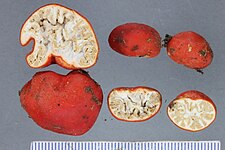Biology:Paurocotylis pila
| Paurocotylis pila | |
|---|---|

| |
| Scientific classification | |
| Domain: | Eukaryota |
| Kingdom: | Fungi |
| Division: | Ascomycota |
| Class: | Pezizomycetes |
| Order: | Pezizales |
| Family: | Pyronemataceae |
| Genus: | Paurocotylis |
| Species: | P. pila
|
| Binomial name | |
| Paurocotylis pila Berk. 1855
| |
Paurocotylis pila is a saprobic, truffle-like ascomycete from the genus Paurocotylis. It is native to New Zealand and Australia and is naturalised in the United Kingdom.[1]
Taxonomy
First described in 1855 by Miles Joseph Berkeley in Joseph Dalton Hooker's The Botany of the Antarctic Voyage II, Flora Novae-Zealandiae[2] The type specimen was found 'on the ground' and was collected by William Colenso in Te Hāwera, South Taranaki in the North Island of New Zealand.[3]
Paurocotylis pila is the only species from the genus Paurocotylis found in New Zealand. Species found in other countries include P. watlingii, P. singeri, P. prima, P. patagonica, P. niveus, P. echinosperma and P. bynumii. [4]
Description
This truffle-like fungus produces a spherical to tuber-shaped fruit body (ascoma) with a smooth surface, which can be lobed or wrinkled. The surface colour can be bright red to orange and the interior tissue is white. The spores found lining the inside of a mature fungi are a cream to yellow colour and have a powdery texture. The interior tissue folds into compartmentalised chambers. P. pila fruit bodies usually range from 10–40 mm in diameter,[5] although some in the UK are up to 60 mm.[6] The fruit body does not have a stipe. There is no odour noted and it is regarded as non-edibile.[7]
Habitat and distribution
This species is found in leaf litter and soil in forests, parks and gardens.[1][7][5][6] It does well in disturbed environments, has been found in abandoned gravel pits [8] and is often along the sides of tracks.[5] It is thought that due to their berry-like shape and striking colour, birds play a role in their dispersal.[7][9]
DNA barcode (internal transcribed spacer) sequences in the National Center for Biotechnology Information (NCBI) database indicate a distribution in New Zealand, Australia and the United Kingdom.[10]
Etymology
Greek, pauro means few and cotylis means cavity, possibly referring to the observed interior of the type specimen.[1] Latin, pila means sphere, presumably referring to the shape of the fruit body.[1]
References
- ↑ 1.0 1.1 1.2 1.3 Kumar, Leticia M.; Smith, Matthew E.; Nouhra, Eduardo R.; Orihara, Takamichi; Sandoval Leiva, Pablo; Pfister, Donald H.; McLaughlin, David J.; Trappe, James M. et al. (2017). "A molecular and morphological re-examination of the generic limits of truffles in the tarzetta-geopyxis lineage – Densocarpa, Hydnocystis, and Paurocotylis" (in en). Fungal Biology 121 (3): 264–284. doi:10.1016/j.funbio.2016.12.004. https://linkinghub.elsevier.com/retrieve/pii/S1878614617300016.
- ↑ "Species Fungorum". https://speciesfungorum.org/Names/NamesRecord.asp?RecordID=183767.
- ↑ "Mycobank database". https://www.mycobank.org/page/Name%20details%20page/name/Paurocotylis%20pila.
- ↑ "Species Fungorum". https://speciesfungorum.org/Names/names.asp?strGenus=Paurocotylis.
- ↑ 5.0 5.1 5.2 "Manaaki Whenua Landcare Research". https://fungalguide.landcareresearch.co.nz/webforms/FG_Genus.aspx?GroupName=Truffle&Group=Paurocotylis&pk=25783.
- ↑ 6.0 6.1 Eggerling, Thomas W. (2004). "Paurocotylis pila" (in en). Field Mycology 5 (2): 41–42. doi:10.1016/S1468-1641(10)60246-0. https://linkinghub.elsevier.com/retrieve/pii/S1468164110602460.
- ↑ 7.0 7.1 7.2 Ridley, Geoff (2022). A photographic guide to mushrooms and other fungi of New Zealand. White Cloud Books. pp. 134. ISBN 9781990003769.
- ↑ Hobart, Caroline (2019). "Paurocotylis pila is still spreading across Britain: some thoughts" (in en). Field Mycology 20 (1): 21–25. doi:10.1016/j.fldmyc.2019.01.007. https://linkinghub.elsevier.com/retrieve/pii/S1468164119300076.
- ↑ Elliott, Todd F.; Jusino, Michelle A.; Trappe, James M.; Lepp, Heino; Ballard, Guy-Anthony; Bruhl, Jeremy J.; Vernes, Karl (2019). "A global review of the ecological significance of symbiotic associations between birds and fungi" (in en). Fungal Diversity 98 (1): 161–194. doi:10.1007/s13225-019-00436-3. ISSN 1560-2745. http://link.springer.com/10.1007/s13225-019-00436-3.
- ↑ "NCBI". https://www.ncbi.nlm.nih.gov/nuccore/?term=paurocotylis%20pila.
Wikidata ☰ Q7155471 entry
 |


